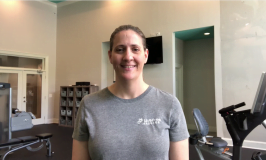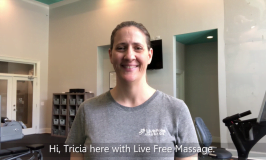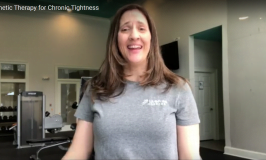Hi, this is Tricia with Live Free Massage. Everyone deals with neck tension, that stiffness you get in the morning when you wake up and also tension at the end of the day when you’re sitting in front of a computer all day. So, today I want to show you stretching all the muscles of the neck to help it stay loose and mobile. It’s a quick and easy routine that you can do any time of the day. So, check it out and I’ll see you soon.
Forward Head Posture
Hi, Tricia here with Live Free Massage. Do you get neck pain or upper back pain and are you starting to get a hump in your upper back, like a lot of people do? Well, today I want to show you how to relieve the pain and improve your posture.
So, this slouched posture will cause the muscles in the front of your neck to get weak, which causes the back of your muscles to get overworked from trying to continually hold your head up against gravity. So, today I wanna show you an exercise that does several things. It’ ll get more extension in your upper back, it will align your neck over your body, and it will strengthen these muscles in the front of your neck to relieve that pain and tension back here. So, let’s get started.
So, get a foam roller and lay down on the floor, with the foam roller across your back. Then, do back extensions like I’m doing here. From your mid-back up through your upper back. Be sure not to compensate by arching your lower back. You want to keep your lower back straight and extend through the upper back. Now, with the foam roller at the base of your neck, put your hands behind your head, with your elbows close together. Now, lift your hips and put pressure on that area. Tuck your chin and allow your neck to fall downward toward the floor. Stay here for 30 seconds. Then, I want you to contract the muscles in the front of your neck and hold your head up for 5 seconds only using the muscles in the front of your neck. You’ll feel them contract. If you feel the muscles in the back of your neck, you are lifting too hard. Do this for 5 to 10 reps.
I recommend doing this exercise every day to get results. I also recommend doing this exercise, as well as other posture exercises, like stretching your chest out and strengthening your back muscles, which you can find on my blog at livefreemassage.com. I hope this helps and I’ll see you soon.
NeuroKinetic Therapy for Chronic Tightness
Hi guys, Tricia here from Live Free Massage, and today I want to talk to you about a technique that I use that gives my clients a lot of success on relieving their pain and chronic tightness. This technique is called NeuroKinetic Therapy or NKT. NKT uses a style of muscle testing to identify compensation patterns in the body. It also helps me as a therapist to narrow in on which muscles to release and which muscles to activate and strengthen. So, to give you an example about what I mean by compensations – take somebody that has chronic tightness in their hamstrings. No matter how much they stretch, their hamstrings are always going to be tight. Now why is that? – Well, when a muscle is working for other muscles that are weak or not firing properly, then these muscles can never relax because they’re always overworking. One common muscle that the hamstrings will work for are the glute muscles. So I’m going to demonstrate how quickly you can lengthen your hamstring muscles just by activating that weak muscle. First I want to show you the end range of my hamstring length. Notice where my hand stops on my foot. Now I’m not going to stretch my hamstring but instead activate my glute muscle by doing a hip extension movement about five times. Now I’m going to recheck the length of my hamstring. Look how much range I gained in just five seconds. So if chronic tightness is something that you struggle with, come on in for a session of NeuroKinetic Therapy. It will give you the knowledge that you need to start balancing your muscles and reliving your pain and tension. I’ll see you next time.
An Easy Way to Increase Muscle Gains in your Workout
An Easy Way to Increase Muscle Gains in your Workout:
Ever see people at the gym working hard but hardly working the muscle they intend? A giveaway is that they are swinging their entire body or jerking their arms, hips, or legs. Their focus is to get the heaviest weight from point A to point B – a good thing. But what they don’t realize is that they are compensating with other muscles to move the weight, resulting in more pain – a bad thing. To make matters worse, the intended muscle group isn’t working all that hard and your gains will be minimal. At the end of the day, your body doesn’t care what muscles it uses, it’s going to engage everything it can to do what you are asking of it, often leading to more pain than you intended.
So for example: if you are performing a straight-arm side raise with a dumbbell, you might compensate by shrugging your shoulder or even side bending to get the weight up. This defeats the purpose of your workout and you may end up hurting yourself.
So to make sure you are getting more muscle gain in your workouts without more pain:
- Find out which muscles you are working for each exercise.
- Focus on engaging that muscle.
- Use a light enough weight that your movement is controlled.
- Stabilize your core.
- Move smoothly from point A to B.
- Then lower the weight with control.
NOTE: Sometimes complex exercises that use multiple muscle groups (i.e. squats) can make it hard NOT to compensate. So try exercises that isolate the muscle you want to strengthen, then build up to these complex moves.
If you believe you have been compensating and are experiencing muscle pain during exercises, then make an appointment with me for Neurokinetic Therapy. We can solve your compensation patterns to relieve your pain and create stronger, more balanced muscles.
Road trip back pain?
You may be facing a long drive to visit family and friends over the holidays. I wonder how your back feels about that? Here are a few tips to help you arrive pain-free.
- Adjust your car seat so your knees are at hip level or slightly below. If your knees are higher than your hips (like in a bucket seat), then your low back spine will be stressed. If your seat doesn’t adjust high enough, you can buy a wedge pillow to help.
- Setup your seat’s lumbar support. Most cars come with lumbar support, but if yours doesn’t, there are many lumbar supports/pillows you can buy that are made for the car.
- Ensure your seat is not reclined too far back. If it is, your head will have to come forward to see the road. This will stress your upper back if you are in this position for a long time.
- Be sure to sit all the way back in the seat rather than slouching. This will help your pelvis and lumbar spine stay in good position during that long trip.
Safe and pain-free travels and happy holidays!





